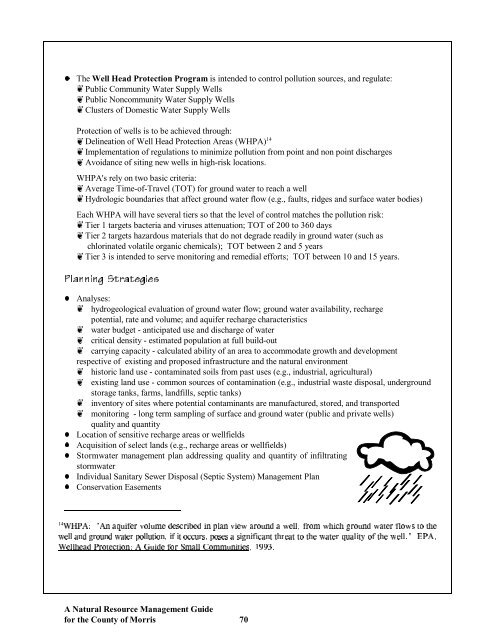A Natural Resource Management Guide for the County of Morris A ...
A Natural Resource Management Guide for the County of Morris A ...
A Natural Resource Management Guide for the County of Morris A ...
You also want an ePaper? Increase the reach of your titles
YUMPU automatically turns print PDFs into web optimized ePapers that Google loves.
YGNNCPFITQWPFYCVGTRQNNWVKQPKHKVQEEWTURQUGUCUKIPKHKECPVVJTGCVVQVJGYCVGTSWCNKV[QHVJGYGNN'2#<br />
9GNNJGCF2TQVGEVKQP#)WKFGHQT5OCNN%QOOWPKVKGU<br />
The Well Head Protection Program is intended to control pollution sources, and regulate:<br />
!<br />
Public Community Water Supply Wells<br />
È<br />
Public Noncommunity Water Supply Wells<br />
È<br />
Clusters <strong>of</strong> Domestic Water Supply Wells<br />
È<br />
Protection <strong>of</strong> wells is to be achieved through:<br />
Delineation <strong>of</strong> Well Head Protection Areas (WHPA) 14<br />
È<br />
Implementation <strong>of</strong> regulations to minimize pollution from point and non point discharges<br />
È<br />
Avoidance <strong>of</strong> siting new wells in high-risk locations.<br />
È<br />
WHPA's rely on two basic criteria:<br />
Average Time-<strong>of</strong>-Travel (TOT) <strong>for</strong> ground water to reach a well<br />
È<br />
Hydrologic boundaries that affect ground water flow (e.g., faults, ridges and surface water bodies)<br />
È<br />
Each WHPA will have several tiers so that <strong>the</strong> level <strong>of</strong> control matches <strong>the</strong> pollution risk:<br />
È Tier 1 targets bacteria and viruses attenuation; TOT <strong>of</strong> 200 to 360 days<br />
È Tier 2 targets hazardous materials that do not degrade readily in ground water (such as<br />
chlorinated volatile organic chemicals); TOT between 2 and 5 years<br />
È Tier 3 is intended to serve monitoring and remedial ef<strong>for</strong>ts; TOT between 10 and 15 years.<br />
Strategies<br />
Planning<br />
Analyses: !<br />
hydrogeological evaluation <strong>of</strong> ground water flow; ground water availability, recharge<br />
È<br />
potential, rate and volume; and aquifer recharge characteristics<br />
water budget - anticipated use and discharge <strong>of</strong> water<br />
È<br />
critical density - estimated population at full build-out<br />
È<br />
carrying capacity - calculated ability <strong>of</strong> an area to accommodate growth and development<br />
È<br />
respective <strong>of</strong> existing and proposed infrastructure and <strong>the</strong> natural environment<br />
historic land use - contaminated soils from past uses (e.g., industrial, agricultural)<br />
È<br />
existing land use - common sources <strong>of</strong> contamination (e.g., industrial waste disposal, underground<br />
È<br />
storage tanks, farms, landfills, septic tanks)<br />
inventory <strong>of</strong> sites where potential contaminants are manufactured, stored, and transported<br />
È<br />
monitoring - long term sampling <strong>of</strong> surface and ground water (public and private wells)<br />
È<br />
quality and quantity<br />
Location <strong>of</strong> sensitive recharge areas or wellfields<br />
!<br />
Acquisition <strong>of</strong> select lands (e.g., recharge areas or wellfields)<br />
!<br />
Stormwater management plan addressing quality and quantity <strong>of</strong> infiltrating<br />
!<br />
stormwater<br />
Individual Sanitary Sewer Disposal (Septic System) <strong>Management</strong> Plan<br />
!<br />
Conservation Easements<br />
!<br />
14<br />
9*2##PCSWKHGTXQNWOGFGUETKDGFKPRNCPXKGYCTQWPFCYGNNHTQOYJKEJITQWPFYCVGTHNQYUVQVJG<br />
A <strong>Natural</strong> <strong>Resource</strong> <strong>Management</strong> <strong>Guide</strong><br />
<strong>for</strong> <strong>the</strong> <strong>County</strong> <strong>of</strong> <strong>Morris</strong> 70


